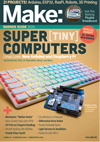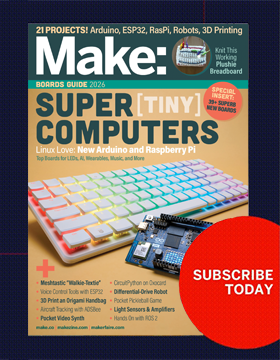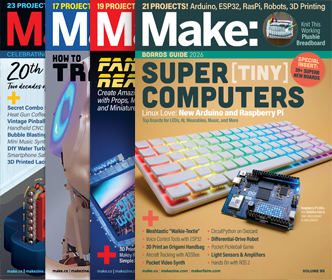Light-Up Whirlybird
under 30 min
Ages 8+
What Will You Make?
In this tutorial, you’ll learn to make a light-up paper helicopter. You can find the original tutorial here.
What Will You Learn?
By completing this tutorial, you’ll learn how to construct an electrified paper toy that spins as it flies.
Build Your Whirlygig
Prepare Your Supplies
Print the template on thick, colorful paper. Choose three Chibitronics Circuit Sticker LEDs for your project.
What Is Happening Here?
Centrifugal Force
This is a STEAM project that combines paper engineering, electronics, and physics. By adding Conductive Fabric Tape and Circuit Sticker LEDs to a paper template that you print out, cut, and fold, you’ll be creating a parallel circuit. In addition to powering the circuit, the coin cell battery and binder clip (used to hold the project together) add weight to the toy to allow it to fly up and spin as it falls. The completed toy is fun to play with, but when you toss in the air, it becomes a visual display of centrifugal force.
What Is Next?
Keep Designing
Some ideas to try:
Decorate your whirlybird with art supplies of your choice.
Experiment with differently sized binder clips to determine how the changes in weight impact the centrifugal force of the toy.
Design Challenge:
How might you extend the circuit so that it might light up both flaps of the helicopter instead of just one?
Hint: A piece of clear tape can be used as an insulator, in areas where you don’t want the positive and negative traces to touch.
Chibitronics Educators Guide
Chibitronics Paper Circuits STEAM Educator’s Guide is a FREE comprehensive guide to STEAM (Science Technology Engineering Art and Math) learning with paper circuits!
This 185-page guide includes:
Overview and history of paper circuits, including materials, techniques and troubleshooting tips
Suggested learning standards
Resources on equitable teaching and collaboration in the classroom
7 detailed lesson sequences based on the Circuit Sticker Sketchbook in Part 1 Lessons
12 detailed lesson sequences based on Love to Code in Part 2 Lessons
6 Featured Projects: cross-curricular adaptable project inspirations
Printable templates for each lesson sequence
Throughout the guide, Chibitronics celebrates artists, educators, art techniques, and projects to showcase inspiring work in action. The arts are interwoven into each activity; STEM becomes a medium to ask and explore big questions about ourselves and the world, and nurture new forms of creativity!
Materials:
- Chibitronics Circuit Sticker LEDs (3)
- Conductive Fabric Tape
- Coin Cell Battery
- Binder Clip (battery holder)
- Thick printer paper or cardstock
- Scissors or craft knife
- Printer for Template
See More Projects in these topics:
Electronics Engineering Paper Crafts Physics STEM or STEAMSee More Projects from these themes:
Art/Craft Studio Carnival/Theme Park The Shop (Makerspace)Chibitronics
Maker Camp Project Standards
Based on NGSS (Next Generation Science Standards)
NGSS (Next Generation Science Standards)
The Next Generation Science Standards (NGSS) are K–12 science content standards. Learn more.Forces and Motion
- 3-PS2-3. Ask questions to determine cause and effect relationships of electric or magnetic interactions between two objects not in contact with each other.
- HS-PS4-5. Communicate technical information about how some technological devices use the principles of wave behavior and wave interactions with matter to transmit and capture information and energy.
CCSS (Common Core State Standards)
The Common Core is a set of high-quality academic standards in mathematics and English language arts/literacy (ELA).Measurement & Data
- Grades K-2
- CCSS.MATH.CONTENT.K.MD.A.1 Describe measurable attributes of objects, such as length or weight. Describe several measurable attributes of a single object.
- CCSS.MATH.CONTENT.1.MD.A.1 Order three objects by length; compare the lengths of two objects indirectly by using a third object.
- CCSS.MATH.CONTENT.1.MD.A.2 Express the length of an object as a whole number of length units, by laying multiple copies of a shorter object (the length unit) end to end; understand that the length measurement of an object is the number of same-size length units that span it with no gaps or overlaps.
- CCSS.MATH.CONTENT.2.MD.A.1 Measure the length of an object by selecting and using appropriate tools such as rulers, yardsticks, meter sticks, and measuring tapes.
- CCSS.MATH.CONTENT.2.MD.A.2 Measure the length of an object twice, using length units of different lengths for the two measurements; describe how the two measurements relate to the size of the unit chosen.
- CCSS.MATH.CONTENT.2.MD.A.3 Estimate lengths using units of inches, feet, centimeters, and meters.
- CCSS.MATH.CONTENT.2.MD.A.4 Measure to determine how much longer one object is than another, expressing the length difference in terms of a standard length unit.
- Grades 3-5
- CCSS.MATH.CONTENT.3.MD.B.3 Draw a scaled picture graph and a scaled bar graph to represent a data set with several categories. Solve one- and two-step "how many more" and "how many less" problems using information presented in scaled bar graphs.
- CCSS.MATH.CONTENT.4.MD.A.1 Know relative sizes of measurement units within one system of units including km, m, cm; kg, g; lb, oz.; l, ml; hr, min, sec. Within a single system of measurement, express measurements in a larger unit in terms of a smaller unit.
- CCSS.MATH.CONTENT.4.MD.C.5 Recognize angles as geometric shapes that are formed wherever two rays share a common endpoint, and understand concepts of angle measurement.
- CCSS.MATH.CONTENT.5.MD.A.1 Convert among different-sized standard measurement units within a given measurement system (e.g., convert 5 cm to 0.05 m), and use these conversions in solving multi-step, real world problems.
- CCSS.MATH.CONTENT.5.MD.C.3 Recognize volume as an attribute of solid figures and understand concepts of volume measurement.
Ratios & Proportional Relationships
- Middle School
- CCSS.MATH.CONTENT.6.RP.A.1 Understand the concept of a ratio and use ratio language to describe a ratio relationship between two quantities.
- CCSS.MATH.CONTENT.6.RP.A.3 Use ratio and rate reasoning to solve real-world and mathematical problems, e.g., by reasoning about tables of equivalent ratios, tape diagrams, double number line diagrams, or equations.
- CCSS.MATH.CONTENT.7.RP.A.1 Compute unit rates associated with ratios of fractions, including ratios of lengths, areas and other quantities measured in like or different units.
- CCSS.MATH.CONTENT.7.RP.A.2 Recognize and represent proportional relationships between quantities.
National Core Arts Standards
The National Core Arts Standards are a process that guides educators in providing a unified quality arts education for students in Pre-K through high school. Also see Standards with cross-cutting anchors in Creating, Performing, Responding, and Connecting through art for Visual Arts.NGSS (Next Generation Science Standards)
The Next Generation Science Standards (NGSS) are K–12 science content standards.Forces and Interactions
- Grades K-2
- K-PS2-1. Plan and conduct an investigation to compare the effects of different strengths or different directions of pushes and pulls on the motion of an object.
- K-PS2-2.Analyze data to determine if a design solution works as intended to change the speed or direction of an object with a push or a pull.
- Grades 3-5
- 3-PS2-1. Plan and conduct an investigation to provide evidence of the effects of balanced and unbalanced forces on the motion of an object.
- 3-PS2-2. Make observations and/or measurements of an object’s motion to provide evidence that a pattern can be used to predict future motion.
- 3-PS2-3. Ask questions to determine cause and effect relationships of electric or magnetic interactions between two objects not in contact with each other.
- 3-PS2-4. Define a simple design problem that can be solved by applying scientific ideas about magnets.
- Middle School
- MS-PS2-1. Apply Newton’s Third Law to design a solution to a problem involving the motion of two colliding objects.
- MS-PS2-2. Plan an investigation to provide evidence that the change in an object’s motion depends on the sum of the forces on the object and the mass of the object.
- MS-PS2-3. Ask questions about data to determine the factors that affect the strength of electric and magnetic forces.
- MS-PS2-4. Construct and present arguments using evidence to support the claim that gravitational interactions are attractive and depend on the masses of interacting objects.
- MS-PS2-5. Conduct an investigation and evaluate the experimental design to provide evidence that fields exist between objects exerting forces on each other even though the objects are not in contact.
- High School
- HS-PS2-1. Analyze data to support the claim that Newton’s second law of motion describes the mathematical relationship among the net force on a macroscopic object, its mass, and its acceleration.
- HS-PS2-2. Use mathematical representations to support the claim that the total momentum of a system of objects is conserved when there is no net force on the system.
- HS-PS2-3. Apply science and engineering ideas to design, evaluate, and refine a device that minimizes the force on a macroscopic object during a collision.
- HS-PS2-4. Use mathematical representations of Newton’s Law of Gravitation and Coulomb’s Law to describe and predict the gravitational and electrostatic forces between objects.
- HS-PS2-5. Plan and conduct an investigation to provide evidence that an electric current can produce a magnetic field and that a changing magnetic field can produce an electric current.
ISTE Standards (International Society for Technology in Education)
The ISTE Standards provide the competencies for learning, teaching and leading in the digital age, providing a comprehensive roadmap for the effective use of technology in schools worldwide.1.1 Empowered Learner
- Summary: Students leverage technology to take an active role in choosing, achieving, and demonstrating competency in their learning goals, informed by the learning sciences.
- 1.1.a Students articulate and set personal learning goals, develop strategies leveraging technology to achieve them and reflect on the learning process itself to improve learning outcomes.
- 1.1.b Students build networks and customize their learning environments in ways that support the learning process.
- 1.1.c Students use technology to seek feedback that informs and improves their practice and to demonstrate their learning in a variety of ways.
- 1.1.d Students understand the fundamental concepts of technology operations, demonstrate the ability to choose, use and troubleshoot current technologies and are able to transfer their knowledge to explore emerging technologies.
1.2 Digital Citizen
- Summary: Students recognize the rights, responsibilities and opportunities of living, learning and working in an interconnected digital world, and they act and model in ways that are safe, legal and ethical.
- 1.2.a Students cultivate and manage their digital identity and reputation and are aware of the permanence of their actions in the digital world.
- 1.2.b Students engage in positive, safe, legal and ethical behavior when using technology, including social interactions online or when using networked devices.
- 1.2.c Students demonstrate an understanding of and respect for the rights and obligations of using and sharing intellectual property.
- 1.2.d Students manage their personal data to maintain digital privacy and security and are aware of data-collection technology used to track their navigation online.
1.3 Knowledge Constructor
- Summary: Students critically curate a variety of resources using digital tools to construct knowledge, produce creative artifacts and make meaningful learning experiences for themselves and others.
- 1.3.a Students plan and employ effective research strategies to locate information and other resources for their intellectual or creative pursuits.
- 1.3.b Students evaluate the accuracy, perspective, credibility and relevance of information, media, data or other resources.
- 1.3.c Students curate information from digital resources using a variety of tools and methods to create collections of artifacts that demonstrate meaningful connections or conclusions.
- 1.3.d Students build knowledge by actively exploring real-world issues and problems, developing ideas and theories and pursuing answers and solutions.
1.4 Innovative Designer
- Summary: Students use a variety of technologies within a design process to identify and solve problems by creating new, useful or imaginative solutions.
- 1.4.a Students know and use a deliberate design process for generating ideas, testing theories, creating innovative artifacts or solving authentic problems.
- 1.4.b Students select and use digital tools to plan and manage a design process that considers design constraints and calculated risks.
- 1.4.c Students develop, test and refine prototypes as part of a cyclical design process.
- 1.4.d Students exhibit a tolerance for ambiguity, perseverance and the capacity to work with open-ended problems.
1.5 Computational Thinker
- Summary: Students develop and employ strategies for understanding and solving problems in ways that leverage the power of technological methods to develop and test solutions.
- 1.5.a Students formulate problem definitions suited for technology-assisted methods such as data analysis, abstract models and algorithmic thinking in exploring and finding solutions.
- 1.5.b Students collect data or identify relevant data sets, use digital tools to analyze them, and represent data in various ways to facilitate problem-solving and decision-making.
- 1.5.c Students break problems into component parts, extract key information, and develop descriptive models to understand complex systems or facilitate problem-solving.
- 1.5.d Students understand how automation works and use algorithmic thinking to develop a sequence of steps to create and test automated solutions.
NGSS MS.Engineering Design
The Next Generation Science Standards (NGSS) are K–12 science content standards.- MS-ETS1-1. Define the criteria and constraints of a design problem with sufficient precision to ensure a successful solution, taking into account relevant scientific principles and potential impacts on people and the natural environment that may limit possible solutions.
- MS-ETS1-2. Evaluate competing design solutions using a systematic process to determine how well they meet the criteria and constraints of the problem.
- MS-ETS1-3. Analyze data from tests to determine similarities and differences among several design solutions to identify the best characteristics of each that can be combined into a new solution to better meet the criteria for success.
- MS-ETS1-4. Develop a model to generate data for iterative testing and modification of a proposed object, tool, or process such that an optimal design can be achieved.
NGSS HS.Engineering Design
The Next Generation Science Standards (NGSS) are K–12 science content standards.- HS-ETS1-1. Analyze a major global challenge to specify qualitative and quantitative criteria and constraints for solutions that account for societal needs and wants.
- HS-ETS1-2. Design a solution to a complex real-world problem by breaking it down into smaller, more manageable problems that can be solved through engineering.
- HS-ETS1-3. Evaluate a solution to a complex real-world problem based on prioritized criteria and trade-offs that account for a range of constraints, including cost, safety, reliability, and aesthetics as well as possible social, cultural, and environmental impacts.
- HS-ETS1-4. Use a computer simulation to model the impact of proposed solutions to a complex real-world problem with numerous criteria and constraints on interactions within and between systems relevant to the problem.
NGSS 3-5.Engineering Design
The Next Generation Science Standards (NGSS) are K–12 science content standards.- 3-5-ETS1-1. Define a simple design problem reflecting a need or a want that includes specified criteria for success and constraints on materials, time, or cost.
- 3-5-ETS1-2. Generate and compare multiple possible solutions to a problem based on how well each is likely to meet the criteria and constraints of the problem.
- 3-5-ETS1-3. Plan and carry out fair tests in which variables are controlled and failure points are considered to identify aspects of a model or prototype that can be improved.













